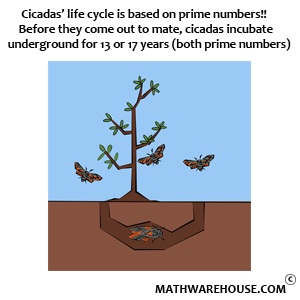Quick Overview
- The Quotient Rule: If $$\displaystyle h(x) = \frac{f(x)}{g(x)}$$ then $$\displaystyle h'(x) = \frac{g(x)\cdot f'(x) - f(x)\cdot g'(x)}{[g(x)]^2}$$.
- If you think of the function as $$h(x) = \frac{\mbox{high}}{\mbox{low}}$$, then the quotient rule becomes
$$h'(x) = \frac{\mbox{low}\cdot d\mbox{high} - \mbox{high}\cdot d\mbox{low}}{\mbox{low-squared}}$$
where $$d$$ stands for derivative. It becomes a little chantLow dee high, high dee low...

Examples
Example 1
Suppose $$\displaystyle f(x) = \frac{2x+3}{5x + 1}$$. Find $$f'(x)$$.
Step 1Differentiate using the Quotient Rule. Parts in $$\blue{blue}$$ are related to the numerator $$\blue{2x+3}$$
$$ f'(x) = \frac{(5x+1)\cdot \blue 2 - \blue{(2x+3)}\cdot 5}{(5x+1)^2} $$
Step 2Simplify the numerator.
$$ \begin{align*} f'(x) & = \frac{2(5x+1) - 5(2x+3)}{(5x+1)^2}\\[6pt] & = \frac{10x+2 - 10x-15}{(5x+1)^2}\\[6pt] & = \frac{-13}{(5x+1)^2} \end{align*} $$
Answer$$\displaystyle f'(x) = -\frac{13}{(5x+1)^2}$$
Note: There is no reason to expand the denominator. In fact, doing so will make the derivative harder to work with.
Example 2
Suppose $$\displaystyle f(x) = \frac{x^2 + 6}{4x+3}$$. Find $$f'(x)$$.
Step 1Differentiate using the quotient rule. The parts in $$\blue{blue}$$ are related to the numerator.
$$ \begin{align*} f'(x) & = \frac{(4x+3)\cdot\blue{2x}-\blue{(x^2+6)}\cdot 4}{(4x+3)^2} \end{align*} $$
Step 2Simplify the numerator.
$$ \begin{align*} f'(x) & = \frac{(4x+3)\cdot 2x-(x^2+6)\cdot 4}{(4x+3)^2}\\[6pt] & = \frac{8x^2+6x-4x^2-24}{(4x+3)^2}\\[6pt] & = \frac{4x^2+6x-24}{(4x+3)^2} \end{align*} $$
Answer$$\displaystyle f'(x) = \frac{4x^2+6x-24}{(4x+3)^2}$$.
Example 3
Find $$\displaystyle \frac d {dx}\left(\tan kx\right)$$ where $$k$$ is any constant.
Step 1Express $$\tan kx$$ in terms of sine and cosine.
$$ \tan x = \frac{\sin kx}{\cos kx} $$
Step 2Differentiate using the quotient rule. Parts in $$\blue{blue}$$ are related to the numerator.
$$ \begin{align*} \frac d {dx}\left(\tan kx\right) & = \frac d {dx}\left(\frac{\blue{\sin kx}}{\cos kx}\right)\\[6pt] & = \frac{\cos kx\cdot\blue{k\cos kx} - \blue{\sin kx}\,(-k\sin kx)}{\cos^2 x}\\[6pt] & = \frac{k\left(\cos^2 kx + \sin^2 kx\right)}{\cos^2 x} \end{align*} $$
Step 3Simplify using trigonometric identities.
$$ \begin{align*} \frac d {dx}\left(\tan x\right) & = \frac{k\left(\cos^2 kx + \sin^2 x\right)}{\cos^2 kx}\\[6pt] & = \frac k {\cos^2 kx}\\[6pt] & = k\,\sec^2 kx \end{align*} $$
Answer$$\displaystyle \frac d {dx}\left(\tan kx\right) = k\sec^2 kx$$


















